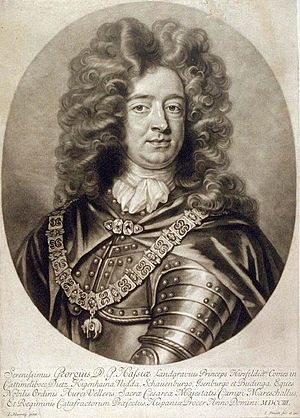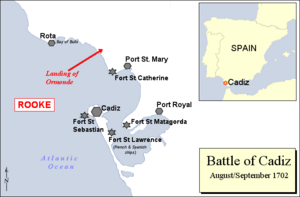Battle of Cádiz (1702) facts for kids
Quick facts for kids Battle of Cádiz |
|||||||
|---|---|---|---|---|---|---|---|
| Part of the War of the Spanish Succession | |||||||
 Contemporary map of the Battle of Cádiz 1702. |
|||||||
|
|||||||
| Belligerents | |||||||
| Commanders and leaders | |||||||
| Strength | |||||||
| 300 regulars and 150 horsemen |
50 ships:
|
||||||
The Battle of Cádiz happened in August and September 1702. It was a fight where England and the Netherlands tried to take the important Spanish port city of Cádiz. This happened during the War of the Spanish Succession.
Cádiz was a major trading hub between Spain and the Americas. Taking it would cut Spain's ties to its colonies. It would also give the Allies a key base. From here, their ships could control the western Mediterranean Sea.
The Allies also tried to get King Peter II of Portugal to join them. They hoped to start a rebellion in Spain. This rebellion would support the Archduke Charles. He was a different person who wanted to be king of Spain.
This battle was the first big fight of the war in Spain. But the Allies had problems. Their army and navy didn't work well together. There was also a lot of bad behavior from the soldiers. The Spanish defense was also very good, led by the Marquis of Villadarias. Because of these issues, Admiral George Rooke could not capture Cádiz. After about a month, his fleet sailed back home.
Contents
Why the Battle of Cádiz Happened
On May 15, 1702, a group of countries called the Grand Alliance declared war. This group included England and the Dutch Republic. They declared war on France and Spain. The Holy Roman Emperor, Leopold I, also declared war.
The Emperor's forces had already started fighting in Italy. They wanted to take control of the Spanish Duchy of Milan. Their success in 1701 made England excited to fight France. It also helped convince King William III to send an Allied fleet to the Mediterranean Sea.
The Allies had several reasons for wanting to be in the Mediterranean.
- They wanted to protect trade ships.
- They wanted to challenge France's powerful navy based in Toulon.
- They hoped to gain support in southern Italy for their side.
But first, the Allies needed a naval base in the Iberian Peninsula. They decided that Cádiz was the best choice. Capturing Cádiz would open the Straits. It would also give them control over trade with the New World. This plan was made before King William III died in 1702. Queen Anne and her ministers continued with the plan.
England also wanted to show its strength to King Peter II of Portugal. They hoped this would make him join the Grand Alliance. He had recently made agreements with France and Spain. Prince George of Hesse-Darmstadt helped with these efforts. The Allies hoped he could lead a rebellion in Spain. This rebellion would support the Archduke Charles as the new king of Spain.
Getting Ready for Battle
The English and Dutch fleet sailed at the end of July. They passed the coast of Portugal on August 20. Admiral Rooke led 50 warships and many transport ships. In total, there were 160 ships. The army commander, Ormonde, had 14,000 soldiers. This included 10,000 English troops and 4,000 Dutch troops.
Admiral Rooke was not confident about the mission. His ships did not have enough food for a long fight. He also worried about the French port of Brest being a threat.
Prince George of Hesse-Darmstadt joined the fleet. He and another diplomat told Rooke that Cádiz was not well defended. But Rooke's own information, from captured fishermen, said the city had a strong Spanish army. The Spanish also lit many fires on the hills. This made the Allies think the Spanish forces were even bigger.
The Allied fleet arrived off Cádiz on August 23. They spent three days discussing what to do. They had several ideas for how to attack.
- One idea was to force their way into the harbor. But this was thought to be too risky for their ships.
- Another idea was to land the army on a narrow strip of land near Cádiz. Then the troops would attack the city. Ormonde liked this plan. But it was too hard for the navy to bring supplies there every day.
- A third idea was to block the city and bombard it with cannons. But the ships could not get close enough to shoot effectively. Prince George also did not want to damage the city. He feared it would make the people angry.
So, they decided to land the troops between the Bay of Bulls and Fort Saint Catherine. This spot was good for the navy. Their ships could get close to the shore. From there, the troops could take the towns of Rota and Port Saint Mary. However, this landing spot was far from Cádiz itself. (See map below).
Don Francisco del Castillo, Marquis of Villadarias, was in charge of defending the area. Cádiz had only about 300 poorly equipped soldiers. But when the Allied fleet appeared, everyone got ready to fight. People from nearby cities helped. Nobles joined the army. Farmers formed groups of soldiers. Villadarias quickly had a strong force. He also blocked the harbor entrance with a strong chain and sunken ships.
The Battle Begins
Landing and Taking Over Towns
The Allied troops landed on August 26. It was windy, and about 25 landing boats were lost. Twenty men drowned. Spanish soldiers with four cannons and some cavalry tried to stop them. But the Allied grenadiers pushed back the Spanish horsemen.
From the landing spot, Ormonde's troops marched to Rota. The town was empty at first. But later, the governor and some people returned to greet them. The Allies stayed there for two days. They unloaded horses and supplies.
Prince George was put in charge of the local government in any town the Allies took. He gave out papers asking Spaniards to support the Archduke Charles. Some people in Rota did join the Allies. But Spanish leaders had threatened to hang anyone caught with Prince George's papers.
The Allies then took Fort Saint Catherine. After that, they entered the town of Port Saint Mary. Ormonde's men camped outside the town at first. But then they were allowed to go into the town. This was a big mistake.
The town was full of unguarded warehouses. These warehouses had many goods, wine, and brandy. Much of it belonged to English and Dutch merchants who used Spanish names. The soldiers took what they wanted. They lost control and started looting and destroying things. They even plundered churches.
Prince George was very upset. He reported that the officers, especially Ormonde's helpers, were to blame. The navy was not involved in the looting at first. But soon, they also started taking things.
The bad behavior of Ormonde's men hurt the Allies' cause. They plundered Saint Mary completely. One local merchant wrote that the fleet left such a "filthy stench" that it would take ages to forget. This looting made it impossible for the local people to join the Allies. It also helped the Spanish spread anti-Allied messages. Admiral Rooke himself said the plundering made a "great noise" everywhere.
Leaving Cádiz
The looting made the expedition much harder. The army was more interested in taking their stolen goods home. They lost their desire to fight. The navy worried about their ships being anchored in a dangerous spot.
The army needed help from the navy for their long march. Sailors built bridges, dug trenches, and carried supplies. But many sailors got sick. Rooke had to limit these demands on his men. He said such hard work was "not for seamen." This decision hurt the relationship between the army and navy.
After taking Port Saint Mary, the Allied advance slowed down. The English generals became difficult. But a Dutch general wanted to attack Fort Matagorda. This fort was near the entrance to the inner harbor. Taking it would let Rooke's fleet enter and destroy enemy ships.
The Allies tried to build a path to the fort. But they were too close to the Spanish ships. They were also attacked by Spanish galleys.
Meanwhile, Villadarias kept attacking small Allied groups. He cut off their supplies. He also suddenly recaptured Rota. The former governor, who had joined the Allies, was executed for being a traitor.
The Allies made little progress. Matagorda held out. After several days, Rooke said that even if they took the fort, another stronghold would still block the fleet. So, on September 26, they decided to load the troops back onto the ships. A plan to bombard the city was canceled due to bad weather. The fleet left on September 30. The attempt to take Cádiz had completely failed.
What Happened After the Battle
No important Spanish people joined the Allies during their time at Cádiz. This was a loss for Prince George. But he did meet with some Spanish nobles who wanted to support the Archduke Charles. They said they would declare for him if the Allies promised enough support. They wanted the Allies to leave troops in Spain for the winter. But this help was not given.
However, some people from Spain did switch sides. The most surprising was the Admiral of Castile, Juan de Cabrera. He left Madrid in September 1702. He went to Portugal and spoke out against the Spanish government. He then joined the Archduke Charles's service.
Ormonde and Prince George wanted to land at another place in Spain. But Rooke was worried about autumn storms. He decided to head back to England. By this time, Ormonde and Rooke were barely speaking. Ormonde thought he could have taken Cádiz if Rooke had not stopped his plan. Rooke was angry about the soldiers' behavior on shore.
Luckily for Rooke, Ormonde, and the Allies, news arrived. A Spanish silver fleet from America was off the coast of Galicia. The battle that followed, the Battle of Vigo Bay, was much more successful than the attempt on Cádiz. This victory made the failed Cádiz expedition seem less bad.
When the fleet returned to England, the House of Lords wanted an investigation. They wanted to know what happened at Cádiz. The success at Vigo Bay helped Rooke and Ormonde. The Tories made Rooke a hero. Ormonde also received a big welcome.
The investigation became a political fight. The Tories praised Rooke and Ormonde. The Whigs were still critical. Both commanders defended their actions. However, a Court-Martial was held for two of Ormonde's officers. One was cleared, but the other was dismissed from service. He was later reinstated.
Images for kids
See also
 In Spanish: Batalla de Cádiz (1702) para niños
In Spanish: Batalla de Cádiz (1702) para niños






